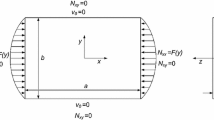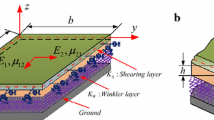Abstract
In the present paper, a nth-order shear deformation theory is used to perform the free vibration analysis of the isotropic plates. The present nth-order shear deformation theory satisfies the zero transverse shear stress boundary conditions on the top and bottom surface of the plate. Reddy’s third order theory can be considered as a special case of present nth-order theory (n=3). The governing equations and boundary conditions are derived by the principle of virtual work. The governing differential equations of the isotropic plates are solved by the meshless radial point collocation method based on the thin plate spline radial basis function. The effectiveness of the present theory is demonstrated by applying it to free vibration problem of the square and circular isotropic plate.

Similar content being viewed by others
References
Reissner E (1945) Reflection on the theory of elastic plates. J Appl Mech 38:1453–1464
Mindlin RD (1951) Influence of rotary inertia and shear on flexural motions of isotropic elastic plates. J Appl Mech 18:31–38
Ambartsumian SA (1958) On the theory of bending plates. Izv Otd Tech Nauk AN SSSR 5:69–77
Levinson M (1980) An accurate simple theory of static and dynamics of elastic plates. Mech Res Commun 7:343–350
Touratier M (1991) An efficient standard plate theory. Int J Eng Sci 29(8):901–916
Soldatos KP (1992) A transverse shear deformation theory for homogeneous monoclinic plates. Acta Mech 94:195–200
Karama M, Afaq S, Mistou S (2003) Mechanical behaviour of laminated composite beam by new multi-layered laminated composite structures model with transverse shear stress continuity. Int J Solids Struct 40:1525–1546
Aydogdu M (2009) A new shear deformation theory for laminated composite plates. Compos Struct 89(1):94–101
Reddy JN (2004) Mechanics of laminated composite plates and shells: theory and analysis, 2nd edn. CRC Press, Boca Raton
Carrera E (2003) A historical review of zig-zag theories for multilayered plates and shells. Appl Mech Rev 56:290–309
Murakami H (1986) Laminated composite plate theory with improved inplane response. J Appl Mech 53:661–666
Demasi L (2005) Refined multilayered plate elements based on Murakami zig-zag functions. Compos Struct 70:308–316
Carrera E (2004) On the use of Murakami’s zig-zag function in the modeling of layered plates and shells. Comput Struct 82:541–554
Reissner E (1984) On a certain mixed variational theory and a proposed applications. Int J Numer Methods Eng 20:1366–1368
Reissner E (1986) On a mixed variational theorem and on a shear deformable plate theory. Int J Numer Methods Eng 23:193–198
Carrera E (2001) Developments, ideas, and evaluations based upon Reissner’s mixed variational theorem in the modeling of multilayered plates and shells. Appl Mech Rev 54:301–329
Carrera E (2000) An assessment of mixed and classical theories on global and local response of multilayered orthotropic plates. Compos Struct 50:183–198
Carrera E (1998) Mixed layer-wise models for multilayered plates analysis. Compos Struct 43:57–70
Carrera E (2001) Developments, ideas and evaluations based upon the Reissner’s mixed variational theorem in the modeling of multilayered plates and shells. Appl Mech Rev 54:301–329
Carrera E (2003) Historical review of zig-zag theories for multilayered plates and shells. Appl Mech Rev 56:287–308
Demasi L (2009) ∞6 mixed plate theories based on the generalized unified formulation. Part I: Governing equations. Compos Struct 87:1–11
Demasi L (2009) ∞6 mixed plate theories based on the generalized unified formulation. Part II: Layerwise theories. Compos Struct 87:12–22
Demasi L (2009) ∞6 mixed plate theories based on the generalized unified formulation. Part III: Advanced mixed high order shear deformation theories. Compos Struct 87:183–194
Demasi L (2009) ∞6 mixed plate theories based on the generalized unified formulation. Part IV: Zig-zag theories. Compos Struct 87:195–205
Demasi L (2009) ∞6 mixed plate theories based on the generalized unified formulation. Part V: Results. Compos Struct 88:1–16
Wu CP, Chen WY (1994) Vibration and stability of laminated plates based on a local high order plate theory. J Sound Vib 177(4):503–520
Cho KN, Bert W, Striz AG (1991) Free vibrations of laminated rectangular plates analyzed by higher order individual-layer theory. J Sound Vib 145(3):429–442
Plagianakos TS, Saravanos DA (2009) Higher-order layerwise laminate theory for the prediction of interlaminar shear stresses in thick composite and sandwich composite plates. Compos Struct 87(1):23–35
Xiang S, Jiang SX, Bi ZY, Jin YX, Yang MS (2011) A nth-order meshless generalization of Reddy’s third-order shear deformation theory for the free vibration on laminated composite plates. Compos Struct 93:299–307
Xiang S, Jin YX, Bi ZY, Jiang SX, Yang MS (2011) A n-order shear deformation theory for free vibration of functionally graded and composite sandwich plates. Compos Struct 93:2826–2832
Roque CMC, Rodrigues JD, Ferreira AJM Analysis of thick plates by local radial basis functions-finite differences method. Meccanica. doi:10.1007/s11012-011-9501-6
Liew KM, Teo TM (1999) Three-dimensional vibration analysis of rectangular plates based on differential quadrature method. J Sound Vib 220(4):577–599
Liew KM, Wang J, Ng TY, Tan MJ (2004) Free vibration and buckling analyses of shear-deformable plates based on FSDT meshfree method. J Sound Vib 276:997–1017
Author information
Authors and Affiliations
Corresponding author
Rights and permissions
About this article
Cite this article
Xiang, S., Kang, Gw. & Xing, B. A nth-order shear deformation theory for the free vibration analysis on the isotropic plates. Meccanica 47, 1913–1921 (2012). https://doi.org/10.1007/s11012-012-9563-0
Received:
Accepted:
Published:
Issue Date:
DOI: https://doi.org/10.1007/s11012-012-9563-0




